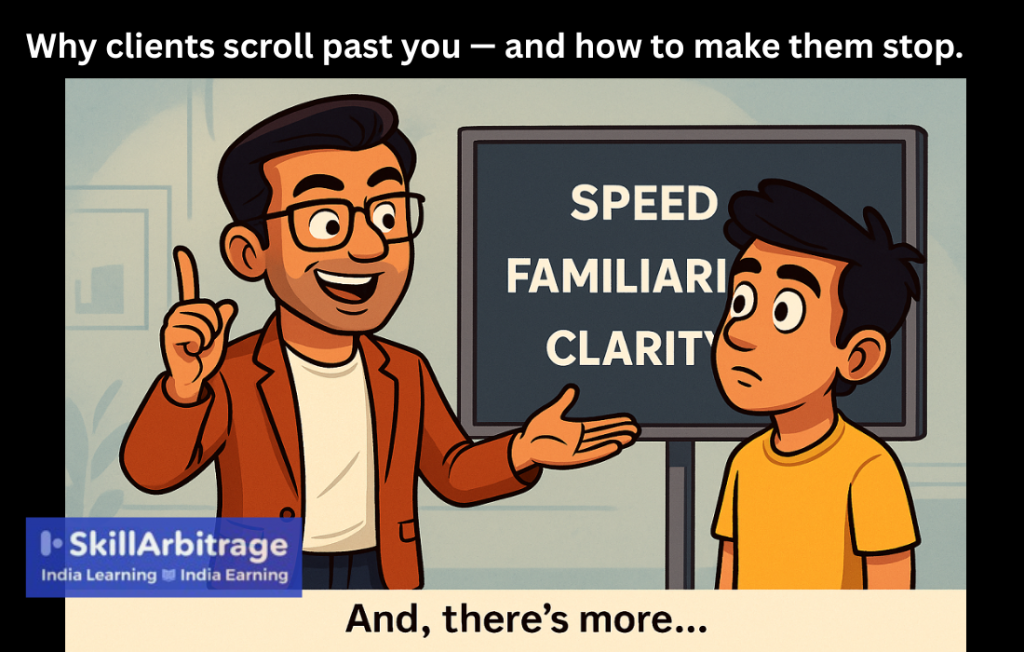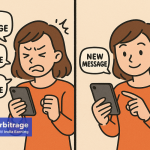This article is for Indian freelancers who feel invisible to high-paying US clients despite having strong portfolios. You’ll learn the hidden hiring filters that determine whether clients see you as a contender or scroll past without a second thought. By the end, you’ll know how to fix the silent red flags in your positioning so clients don’t just notice you, they choose you over the competition.
Table of Contents
Previously on Obstacle to Advantage…
Meera’s brand was in crisis. A scandal threatened everything she had built. Public trust was slipping away.
But Raghunandan reframed it and turned the crisis into proof of demand.
Now, Swathi’s brother, Raja, is eager to break into freelancing. He’s got ambition but no results. Clients aren’t biting. He can’t figure out why.
Raghunandan shows Raja the three hiring filters that separate top freelancers from the ones who stay stuck.
(Continued…)
Swathi’s voice cut through the house like a whip. “You failed every subject?”
Her brother, Rajagopalan Sathyamoorthy Janakiraman Narayanaswami Ranganathan Iyer, Raja for short, slouched on the couch, arms crossed. “It’s not a big deal.”
“Not a big deal?” Swathi clenched her fists. “Do you even understand what this means? What’s your plan now?”
Raja smirked. “Don’t worry, Akka. I’ve got it figured out. I’ll just become a freelancer like Raghunandan Anna. He makes great money, works from home, and doesn’t have a boss breathing down his neck. It’s perfect.”
Parvathishankar, who had been silently watching, let out a thoughtful hum. “Not the worst plan in the world.”
Swathi turned to him, exasperated. “Parvathi Uncle, don’t encourage him.”
Parvathishankar raised a hand. “I’m not encouraging, just observing. The boy is thinking for himself. That’s something.” He looked at Raja. “But tell me, what have you done so far to make this happen?”
Raja hesitated. “Well, I made a profile on Upwork.”
“And?”
“No clients yet, but it’s only been a few weeks.”
Swathi pinched the bridge of her nose. “So, nothing.”
Raja scoffed. “It’s not that hard. I mean, Raghunandan did it.”
Raghunandan, who had been quietly sipping his tea, set the cup down. “You think I just woke up one day and clients started throwing money at me?”
Raja shrugged. “You’re good at writing. That’s all it takes, right?”
Parvathishankar chuckled, shaking his head. “Ah, the sweet optimism of youth.” Then, more gently, he added, “You’re not wrong to think it’s possible. But thinking it’s easy? That’s where you stumble.”
Swathi crossed her arms. “Since you know so much, tell me. Why haven’t you gotten a single client yet?”
Raja exhaled sharply. “I don’t know. Maybe the market’s bad. Maybe the competition is insane. Maybe clients don’t trust Indian freelancers.”
Parvathishankar nodded slowly. “All understandable worries. But maybe there’s more to it.” He gestured toward Raghunandan.
Raghunandan leaned back, studying Raja. “You’re failing an invisible test before they even read your pitch.”
Raja frowned. “What test?”
Parvathishankar smiled. “Now, this should be interesting.”
Raghunandan cracked his knuckles. “Alright. Listen up. You’re not losing because of bad luck or competition. You’re losing because every US client has an invisible hiring filter. If you don’t pass it, they won’t even consider you.”
Raja sat up. “What filter?”
Raghunandan smiled. “There’s more than one. Let me break them down for you.”
Speed: Clients pick those who make hiring effortless
Raghunandan leaned forward, resting his elbows on his knees. “Let’s start with the first filter. The Speed Filter.”
Raja raised an eyebrow. “Speed? Like, replying fast?”
Parvathishankar chuckled. “That helps, but no. Speed is about how easy you make the hiring decision.”
Raghunandan nodded. “Clients don’t sit there analyzing freelancers like an exam paper. They go with the one who makes their life simplest.”
Swathi tilted her head. “Right now, that’s not you.”
Raja sighed. “So what am I doing wrong?”
Raghunandan folded his arms. “It comes down to three things.”
1. Communicate like a local
He held up one finger. “One. You talk like a local. No awkward phrasing. No unnecessary back-and-forth.”
Raja frowned. “I speak good English.”
Parvathishankar smiled. “Speaking well isn’t enough. Clients don’t want to decode what you mean. They want smooth, natural communication.”
2. Understand their industry
Raja tapped his chin. “Okay… What’s next?”
Raghunandan raised a second finger. “You understand their industry instantly. No hand-holding.”
Raja scoffed. “I can’t magically be an expert in everything.”
Swathi smirked. “And yet, you assumed Raghunandan just knew everything when he started.”
Raja rubbed his temples. “Fine. So I research their business before I pitch?”
Raghunandan nodded. “Exactly. If a SaaS founder has to explain what a sales funnel is, you’re already out.”
Parvathishankar shrugged. “The moment they feel like they have to teach you, they lose interest.”
3. Frame your offer clearly
Raghunandan held up a third finger. “Three. You frame your offer so clearly that there’s no guesswork.”
Raja blinked. “What do you mean?”
Raghunandan leaned back. “Hiring is a thinking process. And thinking is effort. If a client has to untangle what you’re offering, they won’t bother.”
Parvathishankar nodded. “People choose the path of least resistance. Always.”
Swathi smirked. “Which is why you never studied for exams.”
Raja groaned. “So, how do I fix that?”
Fix: Hyper-clear pitches
Raghunandan pulled out his phone. “You write hyper-clear pitches. No fluff, no confusion. Make them feel, ‘This guy already knows exactly what I need.’”
Familiarity: Clients pick those who ‘feel right’
Raghunandan leaned forward. “Now, let’s talk about the second filter. The Familiarity Filter.”
Clients hire people who ‘get them’
Raja frowned. “Familiarity? Like, networking? Getting to know them first?”
Parvathishankar chuckled. “Not exactly. But being a stranger doesn’t help.”
Raghunandan shook his head. “It’s not about knowing them personally. It’s about making them feel like you belong in their world.”
Swathi crossed her arms. “Right now, you sound like an outsider.”
Raja groaned. “So what do I do?”
Raghunandan held up three fingers. “It comes down to three things.”
1. Speak their language
He raised one finger. “First, you speak their language instantly. No generic ‘freelancer-speak’.”
Raja raised an eyebrow. “I thought we covered this already.”
Parvathishankar smiled. “We did. But this is deeper. Clients don’t just want clear communication. They want to hear the exact words that make them think, ‘This person gets it.’”
Raghunandan pulled up a SaaS company’s blog. “Look at these headlines.”
- How AI-Powered CRMs Are Redefining Sales Pipelines in 2024
- The Hidden Cost of High Churn Rates (And How to Fix It)
- User Onboarding Mistakes That Cost SaaS Startups Millions
He tapped the screen. “See those words? ‘Sales pipelines.’ ‘Churn rates.’ ‘User onboarding.’ These aren’t just terms. They’re industry markers.”
Raja’s eyes widened. “So if I use these in my pitch…”
Swathi finished the thought. “You stop sounding like an outsider.”
2. Show you understand their pain points
Raja leaned in. “Alright. What’s next?”
Raghunandan raised a second finger. “You show you understand their pain points without them having to spell it out.”
He pulled up LinkedIn, typed ‘SaaS founder hiring a writer,’ and scrolled through posts.
- “We need better blog content, but every freelancer just rewrites what’s already out there.”
- “Hiring SaaS writers is exhausting. Most don’t understand the space, so we waste time explaining.”
- “We need case studies, but good SaaS writers are impossible to find.”
Raja’s jaw dropped. “They’re literally telling us what they need.”
Parvathishankar grinned. “And yet, most freelancers never look.”
3. Frame your offer as the obvious choice
Raghunandan raised a third finger. “Finally, you frame your offer so clearly that there’s no hesitation.”
Raja frowned. “Meaning?”
Raghunandan leaned back. “Clients want certainty. If they have to second-guess whether you’re the right fit, they’ll move on.”
Parvathishankar nodded. “No friction. No confusion.”
Swathi smirked. “Which, again, is why you flunked exams.”
Raja groaned. “Fine. How do I fix it?”
Fix: Familiar, hyper-clear pitches
Raghunandan pulled out his phone. “Your pitches should feel like the client already knows and trusts you.”
Bad Pitch:
“Hi, I’m a freelance writer with experience in multiple industries. I can help you with blog posts, website content, and social media copy. Let me know if you’d like to discuss your needs.”
Raja skimmed it. “Seems fine to me.”
Swathi groaned. “And that’s why you have no clients.”
Raghunandan smirked. “This pitch fails the Familiarity Filter in three ways.”
1. It’s generic. The client has to figure out if you fit.
2. It’s vague. ‘Experience in multiple industries’ means nothing.
3. It asks for effort. ‘Let me know if you’d like to discuss’ puts the burden on them.
Raja frowned. “Okay, so what’s better?”
Raghunandan typed something new.
Good Pitch:
“Hey [Client’s Name], I saw your [company/product] and noticed [specific observation about their industry or content]. I specialize in writing high-converting [type of content] for [their industry]. Here’s a quick example of my work: [link].
If you’re looking for someone who can [specific result they want], I’d love to help. I can send over a quick strategy idea if you’re interested. Let me know, and I’ll get right on it.”
Raja’s eyes widened. “Whoa. That’s way better.”
Parvathishankar nodded. “See the difference? Now, the client doesn’t have to think. The pitch does all the work.”
Raja reread it. “So I…”
1. Show them I already understand their business.
2. Make it obvious how I can help.
3. Offer an easy next step to say yes.
Raghunandan grinned. “Exactly. Now, rewrite your Upwork pitch using this.”
Risk perception gap: The “safest” one wins
Raja leaned back, frowning. “Alright. I get the Familiarity Filter. And I even sound familiar to the prospects, but I still get ghosted.”
Raghunandan smirked. “And do you know why?”
Swathi folded her arms. “Because you feel risky.”
Raja scoffed. “Risky? I’m not some untested rookie. I deliver.”
Parvathishankar chuckled. “It doesn’t matter what you believe. What matters is how safe the client feels hiring you.”
Clients Aren’t Looking for the Best. They Are Looking for the Safest Bet
Raghunandan leaned forward. “Let’s say a client has two options.”
He held up two fingers.
Option 1: A genius freelancer with a vague, risky pitch
Option 2: A decent freelancer who seems 100% reliable
“Who do they hire?” he asked.
Raja hesitated. “The genius?”
Swathi smirked. “Wrong. The safe one.”
Raja frowned. “Even if the genius is better?”
Parvathishankar nodded. “Especially if the genius is better. Because a genius without clarity feels like a gamble. And clients hate gambling.”
Risky Freelancers Make Clients Feel Uneasy
Raghunandan listed the three things that make a freelancer feel risky.
- No Clear Process: If a client doesn’t understand how you work, they assume you’ll be difficult
- No Social Proof: No testimonials, case studies, or references means there is no evidence that you can deliver
- Complicated Pitch: If hiring you feels like effort, they won’t bother
Raja groaned. “I have a process. And I’ve got testimonials.”
Swathi raised an eyebrow. “Do clients see it upfront? Or do they have to ask?”
Raja opened his mouth, then closed it.
Fix: The One-Page Hiring Guide
Parvathishankar grinned. “Time to make yourself the obvious choice.”
Raghunandan grabbed a piece of paper. “You need a One-Page Hiring Guide that removes all friction. Here’s what it should have.”
1. How it works in 3 simple steps
“Break down your process so a client immediately gets it,” Raghunandan said.
Example
1. Discovery Call: We discuss your goals and needs
2. Draft and Review: I deliver a draft within X days for your feedback
3. Final Delivery: You get polished, ready-to-use content
“See,” he continued. “No confusion. No thinking. Just clarity.”
2. Clear pricing or at least a pricing range
Parvathishankar nodded. “The fastest way to lose a client? Make them ask for pricing.”
Raghunandan added, “Give them a number. If it varies, say ‘Starts at X’ or ‘Typical projects range from X to Y.’”
3. Social proof: A testimonial or quick case study
Swathi leaned in. “No one wants to be the first person to trust you. Even one good testimonial can change everything.”
Example
We struggled with our content until Raja stepped in. His work boosted our engagement by 40%
[Client’s Name], [Company]
4. A clear next step so hiring you feels easy
Raja frowned. “Like what?”
Raghunandan scribbled on the paper.
Next step
- Option 1: Book a 15-minute call [Insert Link]
- Option 2: Reply with “Interested,” and I’ll send a quick strategy idea
“No vague ‘Let me know’ nonsense,” he said. “Make it easy to say yes.”
Final test: Would you hire yourself check
Parvathishankar leaned back. “Now, imagine you’re a busy client. You read your own hiring guide. Would you hire yourself?”
Raja stared at the page. Then he grinned. “I’d hire me in a second.”
Swathi smirked. “Yeah, right.”
(To be continued…)







 Allow notifications
Allow notifications
